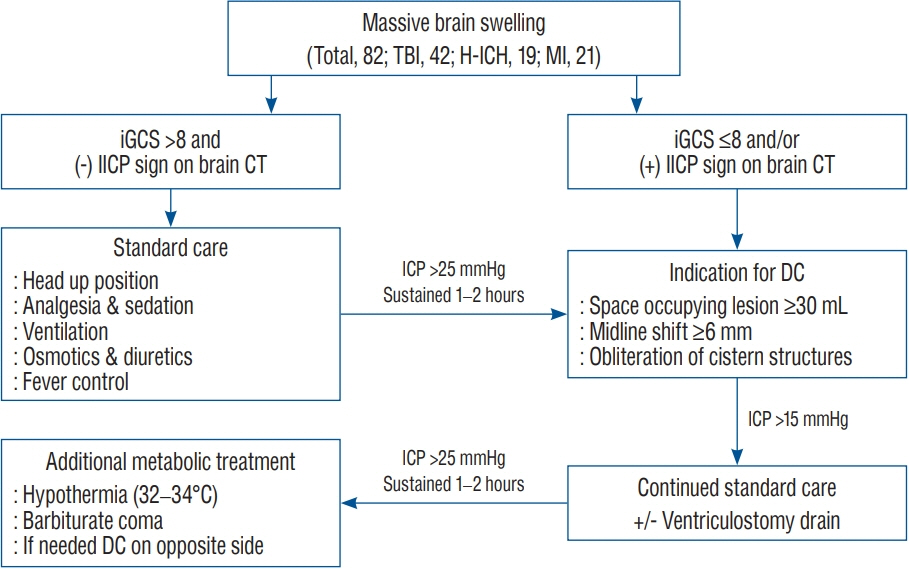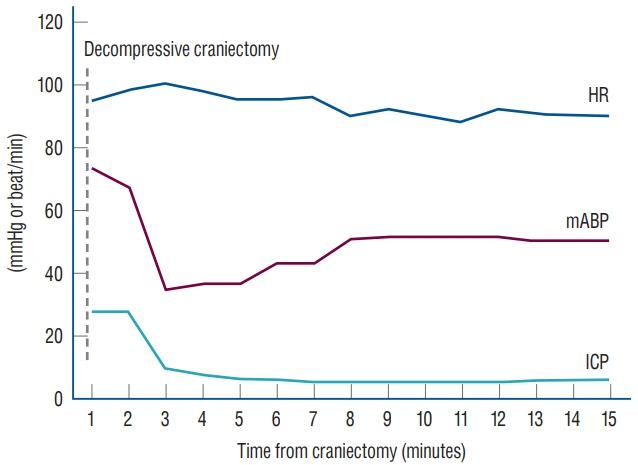J Korean Neurosurg Soc.
2021 Nov;64(6):957-965. 10.3340/jkns.2020.0356.
Changes in Blood Pressure and Heart Rate during Decompressive Craniectomy
- Affiliations
-
- 1Department of Neurosurgery, Bucheon St. Mary’s Hospital, College of Medicine, The Catholic University of Korea, Seoul, Korea
- 2Department of Anesthesiology, Uijeongbu St. Mary’s Hospital, College of Medicine, The Catholic University of Korea, Seoul, Korea
- 3Department of Neurosurgery, Eunpyeong St. Mary’s Hospital, College of Medicine, The Catholic University of Korea, Seoul, Korea
- KMID: 2521986
- DOI: http://doi.org/10.3340/jkns.2020.0356
Abstract
Objective
: Rapid increase in intracranial pressure (ICP) can result in hypertension, bradycardia and apnea, referred to as the Cushing phenomenon. During decompressive craniectomy (DC), rapid ICP decreases can cause changes in mean atrial blood pressure (mABP) and heart rate (HR), which may be an indicator of intact autoregulation and vasomotor reflex.
Methods
: A total of 82 patients who underwent DC due to traumatic brain injury (42 cases), hypertensive intracerebral hematoma (19 cases), or major infarction (21 cases) were included in this prospective study. Simultaneous ICP, mABP, and HR changes were monitored in one minute intervals during, prior to and 5–10 minutes following the DC.
Results
: After DC, the ICP decreased from 38.1±16.3 mmHg to 9.5±14.2 mmHg (p<0.001) and the mABP decreased from 86.4±14.5 mmHg to 72.5±11.4 mmHg (p<0.001). Conversly, overall HR was no significantly changed in HR, which was 100.1±19.7 rate/min prior to DC and 99.7±18.2 rate/min (p=0.848) after DC. Notably when the HR increased after DC, it correlated with a favorable outcome (p<0.001), however mortality was increased (p=0.032) when the HR decreased or remained unchanged.
Conclusion
: In this study, ICP was decreased in all patients after DC. Changes in HR were an indicator of preserved autoregulation and vasomotor reflex. The clinical outcome was improved in patients with increased HR after DC.
Keyword
Figure
Reference
-
References
1. Barbiro-Michaely E, Mayevsky A. Effects of elevated ICP on brain function: can the multiparametric monitoring system detect the ‘Cushing Response’? Neurol Res. 25:42–52. 2003.
Article2. Bharath S, Radhakrishnan M, Umamaheswara Rao GS. Hemodynamic changes during surgical decompression in traumatic brain injury patients. World Neurosurg. 136:e553–e558. 2020.
Article3. Brain Trauma Foundation; American Association of Neurological Surgeons; Congress of Neurological Surgeons; Joint Section on Neurotrauma and Critical Care; AANS/CNS, Bratton SL, et al. Guidelines for the management of severe traumatic brain injury. VIII. Intracranial pressure thresholds. J Neurotrauma 24 Suppl. 1:S55–S58. 2007.4. Broderick JP, Adams HP Jr, Barsan W, Feinberg W, Feldmann E, Grotta J, et al. Guidelines for the management of spontaneous intracerebral hemorrhage: a statement for healthcare professionals from a special writing group of the Stroke Council, American Heart Association. Stroke. 30:905–915. 1999.
Article5. Carney N, Totten AM, O’Reilly C, Ullman JS, Hawryluk GW, Bell MJ, et al. Guidelines for the management of severe traumatic brain injury, fourth edition. Neurosurgery. 80:6–15. 2017.
Article6. Fodstad H, Kelly PJ, Buchfelder M. History of the cushing reflex. Neurosurgery. 59:1132–1137. discussion 1137. 2006.
Article7. Furuichi S, Endo S, Haji A, Takeda R, Nisijima M, Takaku A. Related changes in sympathetic activity, cerebral blood flow and intracranial pressure, and effect of an alpha-blocker in experimental subarachnoid haemorrhage. Acta Neurochir (Wien). 141:415–423. discussion 423- 424. 1999.8. Georgiadis D, Schwarz S, Aschoff A, Schwab S. Hemicraniectomy and moderate hypothermia in patients with severe ischemic stroke. Stroke. 33:1584–1588. 2002.
Article9. Guerra WK, Gaab MR, Dietz H, Mueller JU, Piek J, Fritsch MJ. Surgical decompression for traumatic brain swelling: indications and results. J Neurosurg. 90:187–196. 1999.
Article10. Guild SJ, Saxena UA, McBryde FD, Malpas SC, Ramchandra R. Intracranial pressure influences the level of sympathetic tone. Am J Physiol Regul Integr Comp Physiol. 315:R1049–R1053. 2018.
Article11. Heymans C. The control of heart rate consequent to changes in the cephalic blood pressure and in the intracranial pressure. Am J Physiol. 85:498–506. 1928.
Article12. Hofmeijer J, van der Worp HB, Kappelle LJ. Treatment of space-occupying cerebral infarction. Crit Care Med. 31:617–625. 2003.
Article13. Holtkamp M, Buchheim K, Unterberg A, Hoffmann O, Schielke E, Weber JR, et al. Hemicraniectomy in elderly patients with space occupying media infarction: improved survival but poor functional outcome. J Neurol Neurosurg Psychiatry. 70:226–228. 2001.
Article14. Hutchinson PJ, Kolias AG, Timofeev IS, Corteen EA, Czosnyka M, Timothy J, et al. Trial of decompressive craniectomy for traumatic intracranial hypertension. N Engl J Med. 375:1119–1130. 2016.
Article15. Jiang JY, Xu W, Li WP, Xu WH, Zhang J, Bao YH, et al. Efficacy of standard trauma craniectomy for refractory intracranial hypertension with severe traumatic brain injury: a multicenter, prospective, randomized controlled study. J Neurotrauma. 22:623–628. 2005.
Article16. Jüttler E, Schwab S, Schmiedek P, Unterberg A, Hennerici M, Woitzik J, et al. Decompressive surgery for the treatment of malignant infarction of the middle cerebral artery (DESTINY): a randomized, controlled trial. Stroke. 38:2518–2525. 2007.
Article17. Juvela S, Heiskanen O, Poranen A, Valtonen S, Kuurne T, Kaste M, et al. The treatment of spontaneous intracerebral hemorrhage. A prospective randomized trial of surgical and conservative treatment. J Neurosurg. 70:755–758. 1989.18. Kalmar AF, Van Aken J, Caemaert J, Mortier EP, Struys MM. Value of cushing reflex as warning sign for brain ischaemia during neuroendoscopy. Br J Anaesth. 94:791–799. 2005.
Article19. Kim KT, Park JK, Kang SG, Cho KS, Yoo DS, Jang DK, et al. Comparison of the effect of decompressive craniectomy on different neurosurgical diseases. Acta Neurochir (Wien). 151:21–30. 2009.
Article20. Kocsis B, Fedina L, Pasztor E. Effect of preexisting brain ischemia on sympathetic nerve response to intracranial hypertension. J Appl Physiol (1985). 70:2181–2187. 1991.
Article21. Krasney JA, Koehler RC. Heart rate and rhythm and intracranial pressure. Am J Physiol. 230:1695–1700. 1976.
Article22. Matsuura S, Sakamoto H, Hayashida Y, Kuno M. Efferent discharges of sympathetic and parasympathetic nerve fibers during increased intracranial pressure in anesthetized cats in the absence and presence of pressor response. Brain Res. 305:291–301. 1984.
Article23. McBryde FD, Malpas SC, Paton JF. Intracranial mechanisms for preserving brain blood flow in health and disease. Acta Physiol (Oxf). 219:274–287. 2017.
Article24. Münch E, Horn P, Schürer L, Piepgras A, Paul T, Schmiedek P. Management of severe traumatic brain injury by decompressive craniectomy. Neurosurgery. 47:315–322. discussion 322-323. 2000.
Article25. Rangel-Castilla L, Gopinath S, Robertson CS. Management of intracranial hypertension. Neurol Clin. 26:521–541. x. 2008.
Article26. Reithmeier T, Speder B, Pakos P, Brinker G, Löhr M, Klug N, et al. Delayed bilateral craniectomy for treatment of traumatic brain swelling in children: case report and review of the literature. Childs Nerv Syst. 21:249–253. discussion 254. 2005.
Article27. Robertson SC, Lennarson P, Hasan DM, Traynelis VC. Clinical course and surgical management of massive cerebral infarction. Neurosurgery. 55:55–61. discussion 61-62. 2004.
Article28. Ruf B, Heckmann M, Schroth I, Hügens-Penzel M, Reiss I, Borkhardt A, et al. Early decompressive craniectomy and duraplasty for refractory intracranial hypertension in children: results of a pilot study. Crit Care. 7:R133–R138. 2003.29. Schmidt EA, Despas F, Pavy-Le Traon A, Czosnyka Z, Pickard JD, Rahmouni K, et al. Intracranial pressure is a determinant of sympathetic activity. Front Physiol. 9:11. 2018.
Article30. Schwab S, Aschoff A, Spranger M, Albert F, Hacke W. The value of intracranial pressure monitoring in acute hemispheric stroke. Neurology. 47:393–398. 1996.
Article31. Shelton BA, O’Hara E, Tubbs RS, Shoja MM, Barker FG, Cohen-Gadol AA. Emergency suboccipital decompression for respiratory arrest during supratentorial surgery: the untold story of a surgeon’s courage in times of despair. J Neurosurg. 110:391–394. 2009.
Article32. Smith ER, Carter BS, Ogilvy CS. Proposed use of prophylactic decompressive craniectomy in poor-grade aneurysmal subarachnoid hemorrhage patients presenting with associated large sylvian hematomas. Neurosurgery. 51:117–124. discussion 124. 2002.
Article33. Stefini R, Latronico N, Cornali C, Rasulo F, Bollati A. Emergent decompressive craniectomy in patients with fixed dilated pupils due to cerebral venous and dural sinus thrombosis: report of three cases. Neurosurgery. 45:626–629. discussion 629-630. 1999.34. Stiefel MF, Heuer GG, Smith MJ, Bloom S, Maloney-Wilensky E, Gracias VH, et al. Cerebral oxygenation following decompressive hemicraniectomy for the treatment of refractory intracranial hypertension. J Neurosurg. 101:241–247. 2004.
Article35. Vahedi K, Vicaut E, Mateo J, Kurtz A, Orabi M, Guichard JP, et al. Sequential-design, multicenter, randomized, controlled trial of early decompressive craniectomy in malignant middle cerebral artery infarction (DECIMAL trial). Stroke. 38:2506–2517. 2007.
Article36. Winter CD, Adamides A, Rosenfeld JV. The role of decompressive craniectomy in the management of traumatic brain injury: a critical review. J Clin Neurosci. 12:619–623. 2005.
Article37. Yoo DS, Kim DS, Cho KS, Huh PW, Park CK, Kang JK. Ventricular pressure monitoring during bilateral decompression with dural expansion. J Neurosurg. 91:953–959. 1999.
Article38. Yumoto T, Mitsuhashi T, Yamakawa Y, Iida A, Nosaka N, Tsukahara K, et al. Impact of cushing’s sign in the prehospital setting on predicting the need for immediate neurosurgical intervention in trauma patients: a nationwide retrospective observational study. Scand J Trauma Resusc Emerg Med. 24:147. 2016.
Article
- Full Text Links
- Actions
-
Cited
- CITED
-
- Close
- Share
- Similar articles
-
- Paradoxical Herniation after Decompressive Craniectomy for Acute Subdural Hematoma
- Effects of Decompressive Craniectomy for the Management of Patients with Refractory Intracranial Hypertension
- Paradoxical Transtentorial Herniation Caused by Lumbar Puncture after Decompressive Craniectomy
- Therapeutic Hypothermia for Increased Intracranial Pressure after Decompressive Craniectomy: A Single Center Experience
- Pushed-out Scrylic Bone Flap n Post-traumatic Hydrocephalus



